There are various types of guitar picks based on shape, size, material, and thickness. Picks are commonly made from celluloid, nylon, and tortex, and are found in the 0.5mm to 1.5mm range. Other factors like hardness and texture also affect playability, but this is usually a personal preference.
If you’ve ever walked into a guitar store and asked to see guitar picks, you’ve likely seen boxes filled with plectrums of all kinds. It can get confusing to know which one is best for you unless you’re keen on trying fifty different picks.
So we’ve created a comprehensive guide to every type of guitar pick you can find. And you’ll be able to choose one that suits your playing style perfectly. You might even discover new pick types you’ll want to try!
Post Contents
Guitar Pick Types

Guitar picks can be broadly divided into two types based on playing style: flat picks and finger picks.
Flat Picks
A flat pick is the standard plectrum which is held between the thumb and index finger. Most guitar picks generally refer to these. Flat picks are the easiest to use for a variety of genres, including blues, rock, and metal.
Some of the best flat picks are made from celluloid, nylon, or tortex. They have a good balance of flexibility and rigidity, which makes them ideal for strumming and picking. They also come in a whole range of varieties, as we discuss below.
Finger Picks
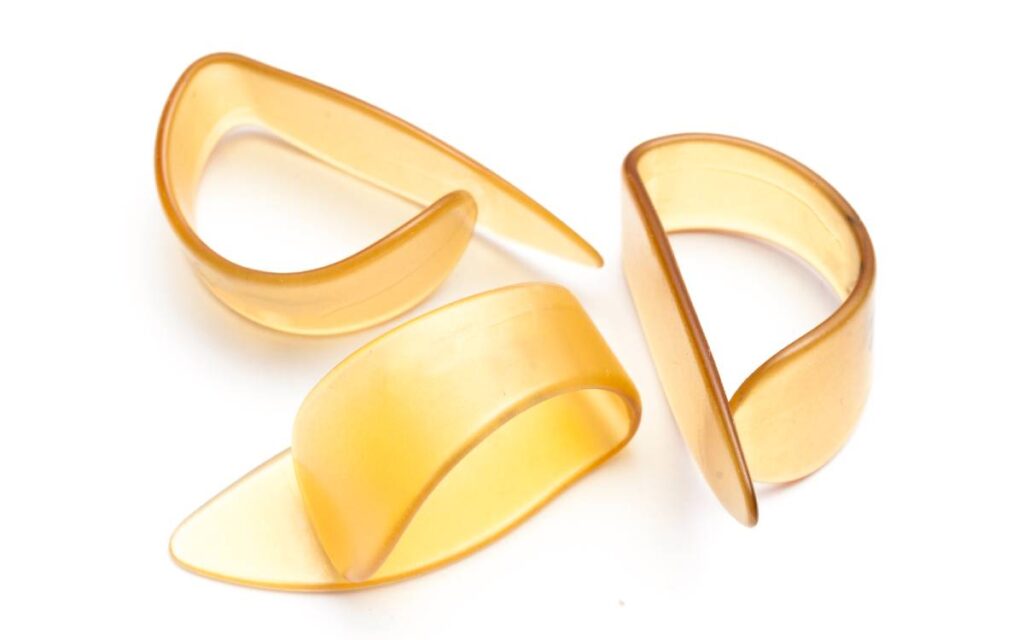
Finger picks (also called thumb picks) are worn on the finger like a ring and are used to pluck the strings. Finger picks are quite versatile since they can be used for a variety of genres, including country, bluegrass, and folk.
They’re typically great for fingerstyle guitarists who want to be able to pluck the strings with precision. But beyond fingerstyle, these aren’t as common as flat picks, and they have fewer varieties since most are made from plastic or metal.
Guitar Pick Shapes And Sizes
You can find guitar picks in a large variety of shapes and sizes, but here are the standard shapes you’re most likely to come across.
Standard Pick Shape

As the name should tell you, the Standard 351 is the most commonly used pick by guitarists everywhere. Most beginners start with this pick, and it’s ideal in just about every playing situation. The standard tip will suit you perfectly if you mostly strum and play some single-note melodies.
The Standard 351 also comes in a sharp tip version, which is larger in size. This should provide you with more clarity in your playing, and will be perfect if you do a lot of riffs and solos with some strumming added in.
Pointy Picks
Pointed picks are less common than standard ones, but they’re gaining popularity due to their unique benefits. Pointed picks are narrower than standard picks, and they have a sharp point at the tip. This gives them more control and precision, making them ideal for fast and complex playing with more articulation.
While this type of pick shape is good for those seeking extra control in their playing, this might not be the best for guitarists who use a lot of strumming as they’re less flexible.
Jazz III Picks
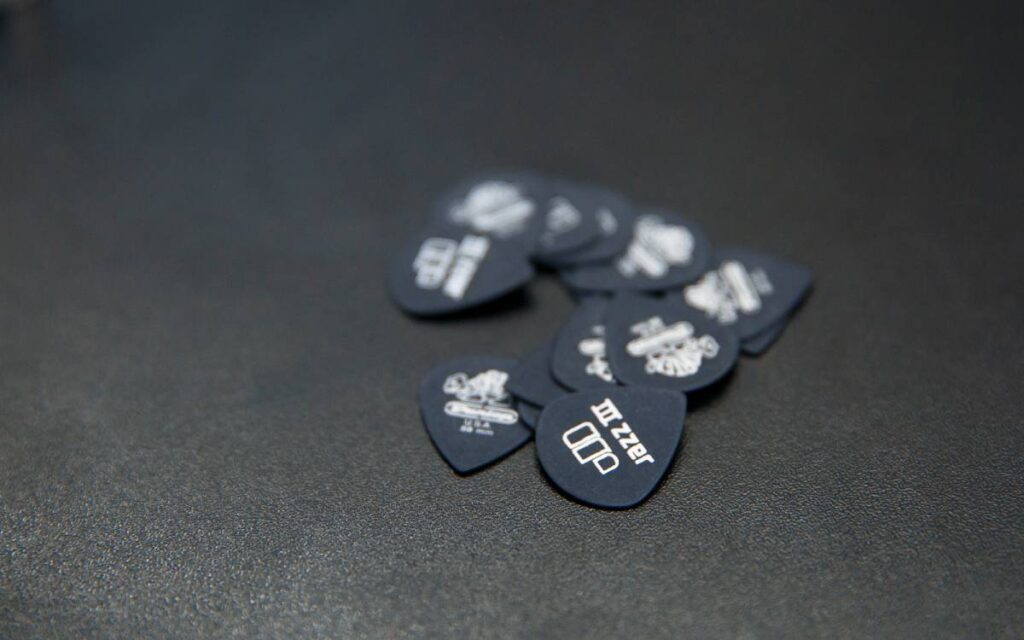
While these picks were initially designed for jazz guitarists, Jazz III picks are small, pointed picks that are popular among rock and metal players. These picks are designed for speed and precision, and they can be used for both strumming and picking.
More advanced guitarists love this pick due to its fast response time and accuracy. These picks tend to be smaller and thicker (more on pick thickness in a bit), which is what influences their sound. The nimble size adds to the accuracy, while the thickness makes these picks have a much stronger attack that’s perfect for solos.
Jazz XL
Jazz XL picks are larger versions of the Jazz III pick. These picks are designed for players who want more control and a fuller sound.
These picks offer the same attack that Jazz III picks do, with the added advantage of being easier to hold. This makes them a great investment for intermediate players who want to go into riffing and soloing. If you find the normal Jazz III is too small, give this one a try.
Triangular Picks
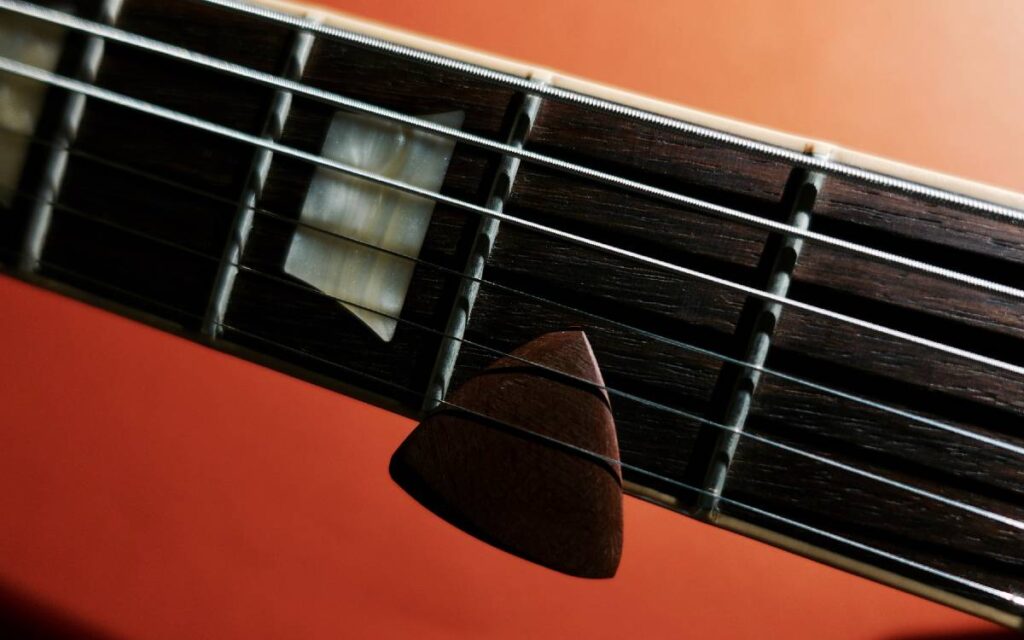
Triangular picks are less common than other shapes, but they’re often used by classical and flamenco guitarists. These picks produce a softer sound than other shapes, and they’re easy to grip.
Triangular picks are available only in a larger size, which makes them score comparatively low on precision but very high on usability. One of the best things about a triangular pick shape is that all the edges are equal in length. This means that if you do wear out one point, you can simply use the other two. And you can hold it however you like!
Sharkfin Picks
Sharkfin picks are a relatively new design, and they’re designed to offer the best of both worlds. These picks have a standard shape with pointed tips, which gives them more control and precision. These are novelty picks and are used by experimental guitarists who love coaxing new sounds from their instruments.
The rounded and pointy sides are perfect for chords and notes respectively, while the wavy edge can always be used to produce some very interesting sounds. However, the pointed ends aren’t quite as pointy as other picks which are dedicated to precision, so sharkfins are often used for strumming chords.
Teardrop Picks
Teardrop picks are designed for comfort and speed. These picks are easy to grip and hold, and they allow you to play quickly and accurately.
Teardrop picks come in two kinds – you could go for the thin teardrop, which is a little less comfortable but offers incredible precision and control, or you could go for the wide teardrop pick shape which has a softer attack and more comfort.
Other Pick Shapes And Sizes

Other picks come in various shapes, but they are mostly extensions of these six shapes. Some are rounder, some are beveled, and some are more angular.
One of the most interesting new players in the market is Rombo Picks. Their picks flaunt unique designs on the body while also remaining ergonomic, and have textures and shapes which offer maximum precision to the player. Their designs are reminiscent of origami, and come in a wide variety of shapes.
Bigger picks, often used by beginners, are easier to hold and suit loose playing styles. These picks aren’t that precise, which is why they’re preferred by those who strum chords and don’t require picking in their music.
Smaller picks are perfect if your playing requires precision. If you’re into jazz or metal music and play a lot of riffs and scale runs, these might be the picks for you. Smaller picks are also perfect for soloing and playing single notes with accuracy.
Rounder picks tend to have a warmer, richer sound and softer attack, which makes them perfect for acoustic guitars. Sharper points on picks are perfect for guitarists who need intensity and brightness in their playing, perfectly suiting soloists, lead guitarists, and even flamenco players.
Guitar Pick Thicknesses
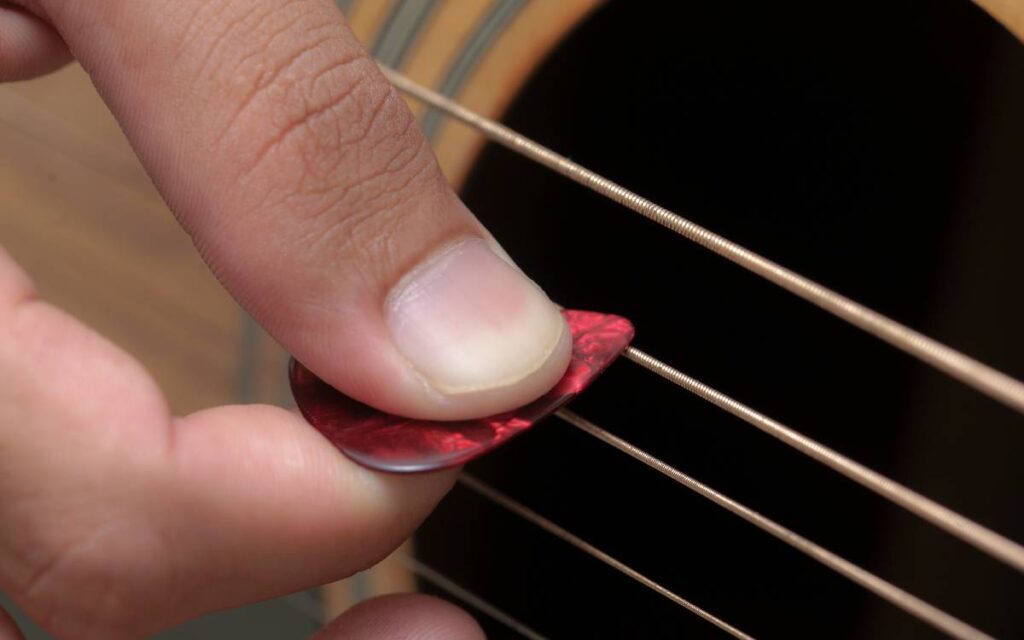
Picks also come in a variety of thicknesses, and the thickness you choose will affect your sound. While there is no set standard for this, here are a few of the common thickness ranges you’ll see.
Extra Light (< 0.45mm)
Extra light picks are the thinnest picks you can find, and they’re designed for players who want a very soft sound. These picks are also easy to bend, so they’re ideal for strumming.
The incredible flexibility of these thin picks makes them a bad choice for soloing, but if you’re mostly playing chords and look for ease in your playing, extra light picks should be the ones you choose. The tone these thin picks produce is bright and lively.
Light (0.45–0.70mm)
Light picks are a good middle ground between thin and thick picks. These picks produce a moderately more powerful sound, and they’re easy to grip and hold.
Light picks tend to have a little more bass and midrange compared to extra light picks, which should suit richer and heavier acoustic styles which require strumming. Keep in mind, however, that these thin picks are still quite flexible and don’t work as effectively for picking arpeggios.
For beginners, starting with a pick in the range of 0.4 to 0.5 mm is a good idea. This will help you develop a better strumming technique, and later you can shift to a thicker pick for more clarity and control – if that’s what you require.
Medium (0.70–0.90mm)
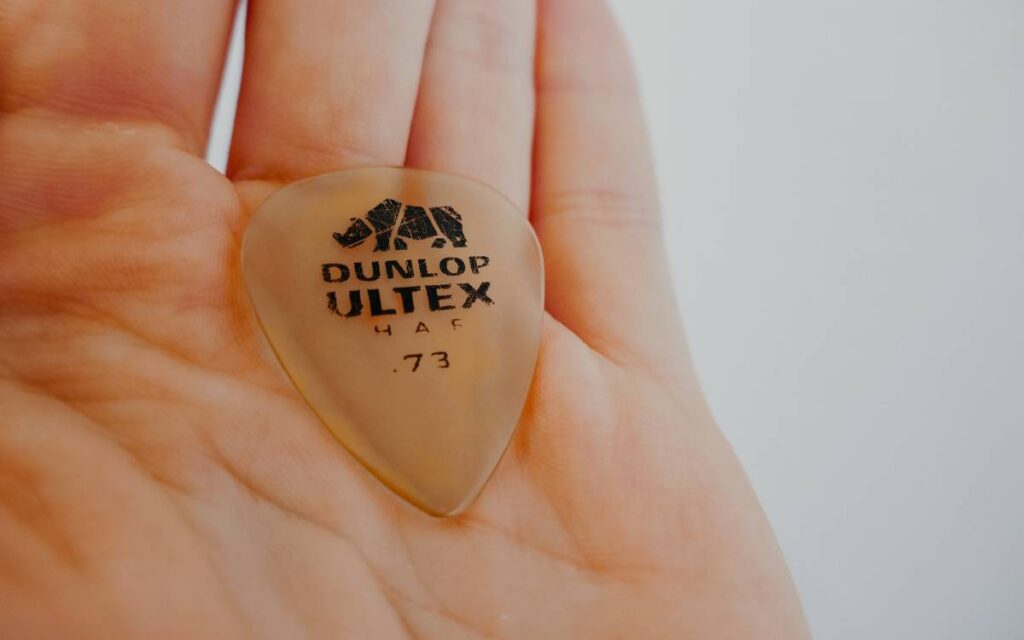
Medium picks are the most common thickness, and they’re designed for players who want a balanced sound and control.
They are surprisingly versatile and suit both picking and strumming, having a well-balanced attack and some warmth. If you’re not sure about where to start, medium picks are a good choice.
Once you have figured out which style of music you want to play and played around more with picks and strings, you can move on to lighter or heavier gauge picks – or stick with mediums if that is what you prefer.
Heavy (0.90–1.5mm)
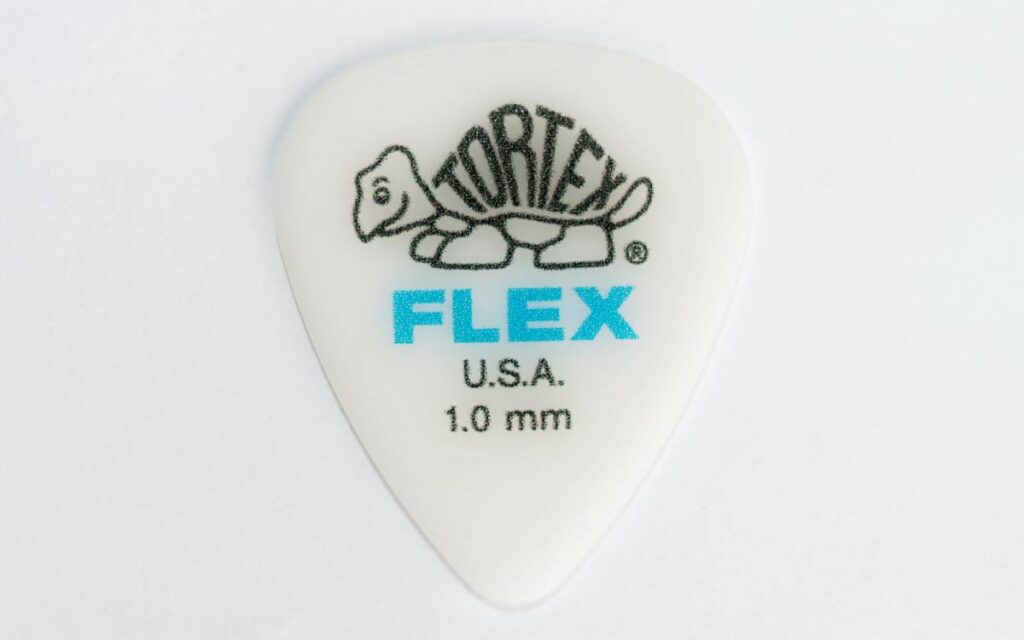
Heavy picks are much thicker than mediums, and they’re designed for players who want a strong, full sound. These picks are also good for players who have a hard time gripping thinner picks. The Jazz III is one of the most popular heavy picks, with a thickness of 1.38mm.
One main advantage of thicker picks is the larger range of dynamics that they provide to the guitarist. They do well under force and are significantly more durable than lighter gauge picks. However, these can feel a little clumsy in your hands unless you use the very tip of the guitar pick, and strumming with them takes some getting used to.
Heavy picks tend to be best suited to bass and electric guitar players who play heavier (pun not intended) genres of music. If you’re playing riffs and solos with an aggressive picking style, you’ll get much better precision and attack with these.
Extra Heavy (>1.5mm)
Extra-heavy picks are the thickest picks you can find, and they’re designed for players who want an even heavier sound. These picks are ideal for rhythm guitarists who want to beef up their tone, as they enhance the bass response from your strings and improve dynamics.
The extra-heavy pick is a jazz musician’s best friend, because of how much attack they can provide. They also perform very well with thicker-stringed guitars, or when you need a bit of extra volume from your instrument. They’re perfect for accurate picking control over every note.
The one downside of using an extra heavy gauge guitar pick is that they can sometimes feel a little clunky to hold. All the extra force that they allow you to use on your guitar can also make them susceptible to being dropped, which is not what you want during a live performance.
If you’re not sure about which thickness is right for you, check this video:
Guitar Pick Materials
Picks are made from a variety of materials, and each one has its own unique sound and feel. Here are some of the most common materials you’ll find.
Celluloid
Celluloid is a classic pick material, and it’s known for its warm, round sound. This material is also very flexible, so it’s easy to grip and hold.
Celluloid, made from nitrocellulose and camphor, is easy to manufacture and commonly found. Even though they make your guitar sound awesome, they downgrade with time, and might be flammable because of the solvent content in them. If you’re performing at an event with pyrotechnics, you might want to keep these picks at home.
Celluloid picks are favored for their smooth feel on strings, and come in a variety of shapes and designs – if you’re looking for a particular print on your pick, you could easily find it on a celluloid plectrum. These picks are best suited for strumming.
Nylon
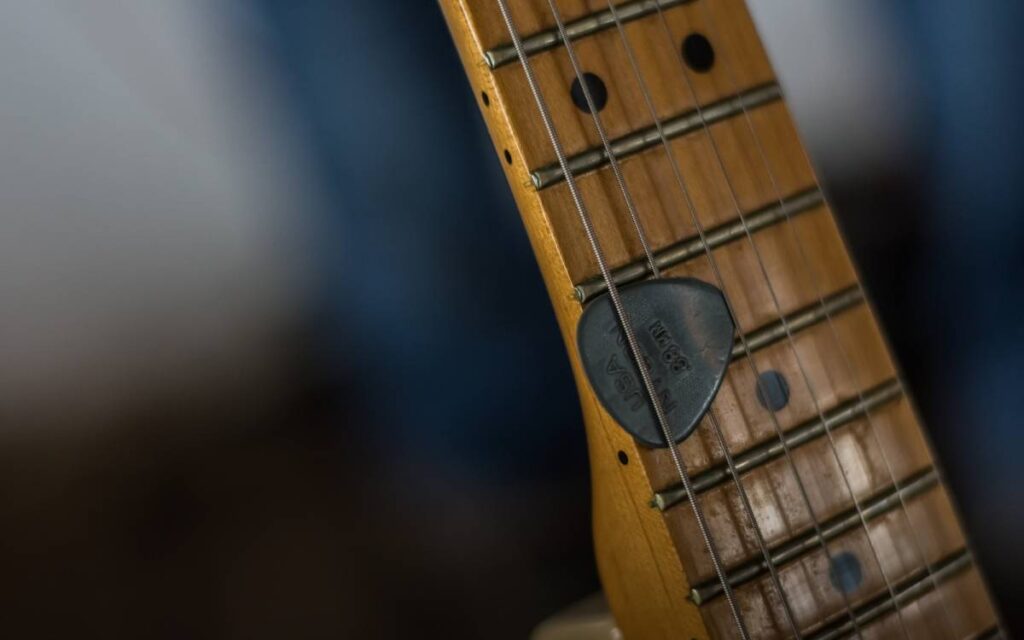
Nylon is a synthetic material that’s known for its bright, articulate sound. Nylon picks are also very strong and durable, making them ideal for players who are hard on their picks.
These picks have been used by greats like Jimmy Page and Gene Simmons for their sunny tone. If you’re a guitarist who likes thicker gauge picks, nylon is a good choice since many thick picks use nylon.
Nylon picks without grooves or sanding are often too slippery to be held for long durations, so if you’ve decided on this material, make sure you choose a pick with grip. Their springy attack will not let you down while riffing and soloing.
Tortex
Dunlop developed Tortex to be a sustainable replacement for tortoiseshell picks – if you’re one of those guitarists who’s always wanted a tortoiseshell pick but you’re environmentally conscious, Tortex is for you.
Tortex picks have fantastic grip despite being smooth, which means that they can handle speedy playing. Their powdered surface protects your fingers from the friction that comes with complicated tunes, but all these qualities mean that they don’t have quite as much attack as some plastic or nylon picks.
Kurt Cobain and James Hetfield are among the renowned musicians who have used Tortex picks in live concerts. You get these in a wide variety of thicknesses and shapes.
Ultex
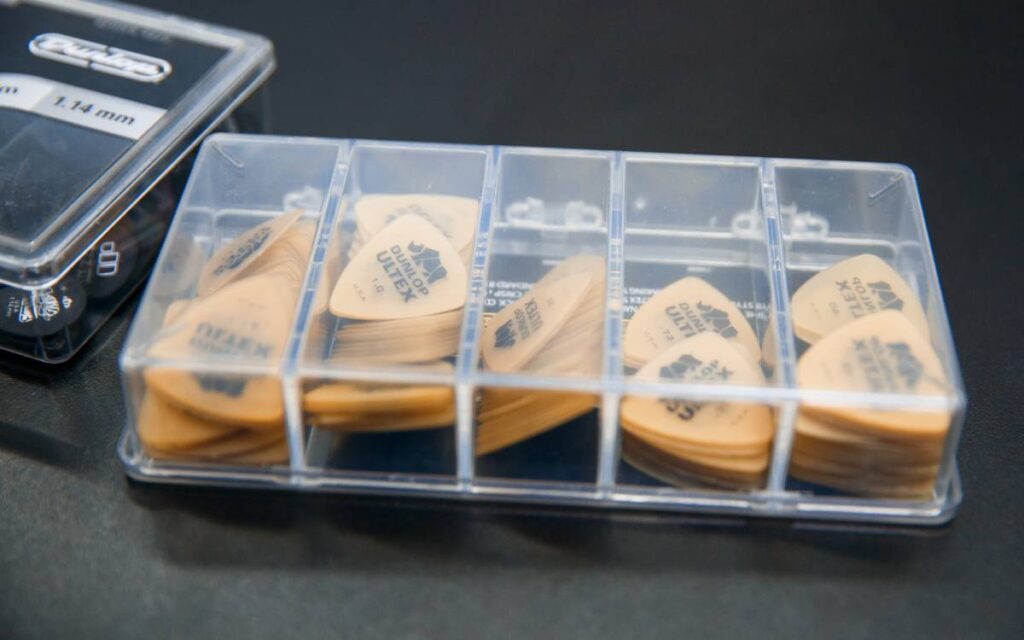
Ultem, or polyetherimide, makes for plectrums that are flexible and pack a punch with their attack. Their lightness makes them unsuitable for power chords and heavy gauge strings, but their dynamics and durability more than compensate.
Ultex is quite similar to Tortex and Acetal, which means that these picks can handle high temperatures and aggressive use. Some Jazz III pick variants also use Ultex, while you can find many other shapes and sizes. The gritty edge provided in Ultex picks provides enough grip to prevent the pick from slipping in your fingers.
Acetal/Delrin
Acetal or Delrin picks are made from resin-based materials which provide great grip and warm tone. Acetal picks are inflexible and durable, making them perfect for rock or metal musicians.
Acetal was created by DuPont, and the company claims that the material is an intermediary between metal and plastic. If your picks tend to go through a rough picking attack, Acetal will serve you well.
However, Acetal picks do not allow the natural tones in acoustic guitars to shine through because of this inflexible nature. They’re better suited for electric guitars.
Stone
Guitarists who like heavy-gauge picks will love stone picks. They impart an unmistakable sound to your guitar, and their rigid structure helps produce overtones that no other pick can. The thickness of stone plectrums also creates great dynamics.
Owing to the inflexibility of stone, these picks are better at playing single-note melodies as opposed to chords. Turquoise, agate, and variscite plectrums are also gorgeous pieces of art and worthy of being collected. Stone picks cannot be mass-produced and thus tend to cost a lot more than other materials.
Wood
Wooden picks can be made from several species of wood, including Rosewood, Mahogany, Walnut, and Blackwood, to name a few. They come in two popular varieties: Sheesham and Surf.
Sheesham wood picks are made from tough wood which makes them quite durable and bright, while Surf picks are made from Lignum Vitae, which is one of the hardest woods on earth.
Wood plectrums, in general, tend to have great volume and sharp attack, and they can make your guitar sound warm and rich. Even the hardest wood plectrums will wear down faster than plastic or nylon plectrums, though.
Metal
As expected, metal picks tend to bring out higher harmonics in your playing, and are some of the most durable picks that you can get your hands on. They’re mostly made from brass, stainless steel, or copper. Their heft makes them great for louder genres of music like punk rock or metal.
Copper picks are the warmest of all metal picks, since copper is the softest metal that can be molded in a plectrum. Steel, on the other hand, will sound bright and energetic, and can last a good deal of rough usage.
Metal guitar picks do have a tendency to damage strings. To correct this, Dunlop makes metal picks with rounded edges to reduce friction on your strings and ensure their longevity. Metal fingerpicks are quite common among fingerstyle guitarists.
Bone
If you have the budget, bone picks are some of the most exotic picks available on the market. Picks also used to be made from ivory, but those have since stopped due to legal and environmental issues.
These bone picks increase the volume of your guitar and favor harmonics in the middle range. They’re mostly thick, which limits the amount of strumming you can do with them.
Tortoise Shell
Tortoiseshell picks are especially hard to find nowadays due to their antique status. They were banned in the ‘70s to protect the Hawksbill turtle, whose shell was the main source of raw material for these picks.
Even though tortoiseshell picks can now cost a fortune, guitarists believe they make your instrument sound warm and more pleasant. They’re also smooth in texture, with enough roughness to maintain grip.
The keratin found in tortoise shells makes these picks very durable, so they do not wear down for a long time – on the off chance that they do wear down, they can be re-sculpted and made as good as new.
While tortoiseshell picks seem like an intriguing investment, these picks are illegal in the US, so we recommend opting for a synthetic variant like Tortex.
Other Materials And Custom Picks
Other than the most common materials used to make picks, abalone, carbon fiber, thermoplastic, and Tusq are also used, albeit they are a little hard to find on the market. If you’re particularly picky about the type of pick you want to use, you could also custom make them.
Companies like Fender and Dunlop offer custom-making services for picks, and even though they do come at a higher price point, they’re a great way to get the exact pick you need.
If you’re wondering how all these guitar picks affect your guitar tone, here’s a video experimenting with that:
Other Factors Affecting Guitar Picks
Hardness
Picks come in all kinds of flexibilities, and depending upon your preference and style of playing, you might want to go for a more rigid or flexible pick. Generally speaking, rigid picks are great for soloing and playing notes, while flexible picks serve you well if you’re mostly a strummer.
If you’re trying to strum with a rigid pick, you might come to realize that the pick itself makes an awful lot of noise when striking the strings, and takes away from the sound of the guitar itself. Similarly, a flexible pick will bend too much to play single notes and lines accurately.
Ultimately, the choice of pick hardness will come down to your style of music and your personal preference.
Texture
Guitar pick textures are all about the amount of grip they provide. Even though different players prefer different textures, it’s always best to choose a pick with some sort of groove on it, so that your fingers do not accidentally slip on the pick and drop it. All acoustic guitarists know the horror of having their pick fall into the soundhole and the ordeal of taking it out.
Nylon picks typically come with a textured surface because of how slippery the material is, since no one wants their pick flying into the crowd in the middle of a gig.
Color

If you’re big on aesthetics, it might be overwhelming to discover the sheer amount of designs that picks offer. Depending upon the material, some picks lend themselves easily to designs and colors, while others might be a bit more subtle.
Picks made of plastic-like material (nylon, celluloid, Tortex) tend to offer more choices when it comes to color and design. You can often find a wide variety of prints, including logos of your favorite bands.
Price
Picks tend to be inexpensive in the beginner range, since they are often mass-produced. You could buy a set of a dozen celluloid picks for $2–$3.
However, if you’re an experienced or professional player, picks can become quite expensive – even more so if you’re using rare or animal-derived materials. The price of such a pick can go upwards of $1. Signature picks, such as the John Petrucci Jazz III, are also quite expensive.
Frequently Asked Questions About Guitar Picks
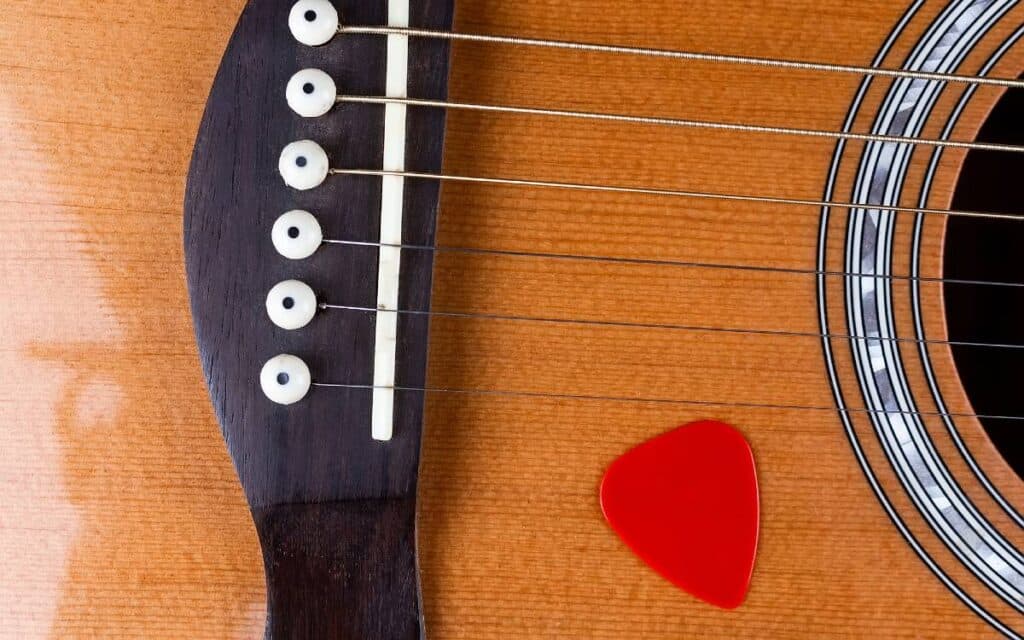
What type of picks are best for acoustic guitar?
An extra light or light pick is best for acoustic guitar, as they’re great for strumming and playing melodic riffs. However, if you find yourself wanting a little more rigidity, a medium pick should also work well. As for material and shape, almost all varieties on the market are good enough for acoustics, but will impact the tone differently.
Which guitar pick is better for beginners?
A light guitar pick made of celluloid in the standard shape and of 0.4 to 0.5mm thickness is suitable for beginners. This pick will help you develop a strong strumming technique, and you can move on to other picks as you develop your playing skills.
Which pick is best for strumming?
Flexible, thin picks are the best for strumming techniques. They offer just enough flex so that they feel natural when you’re playing fast chord patterns. Nylon, acetate, celluloid, and similar materials which aren’t rigid work well with strummers.
Which guitar pick type is best for metal?
A heavy, rigid pick like the Jazz III will give metal guitarists enough attack and dynamics to suit the genre without losing out on precision. Look for materials like nylon or Tortex, and with a pointed end for a sharp attack.
When should I replace a guitar pick?
Guitar picks should ideally be replaced when their playing end starts wearing down. This varies from player to player, but if you find that you’re not hitting notes as accurately because the tip is blunt, you should change the pick. As a rule of thumb, every 4–6 months is a good way to avoid picks being worn out.






